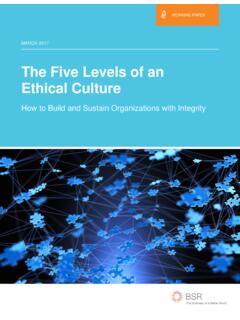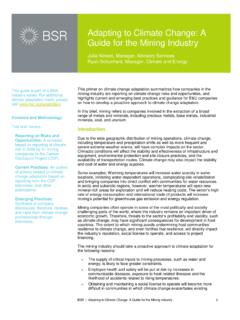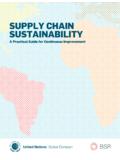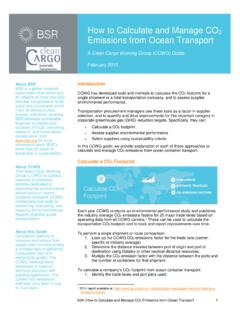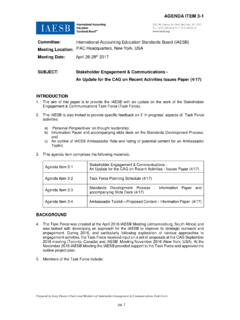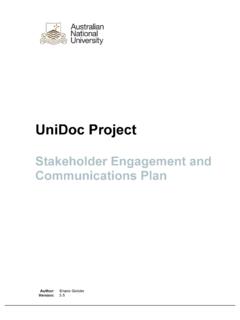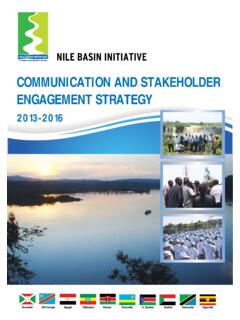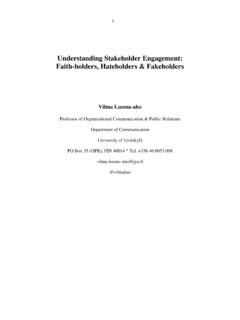Transcription of Stakeholder Engagement Strategy - BSR
1 BSR | Stakeholder Engagement Strategy 1 Introduction Thought leaders and influencers from government, civil society, and the private sector play an important role in creating and maintaining business value. As their influence evolves, companies must take a strategic and structured approach to Stakeholder relations. BSR has developed a five-step approach to show how corporations can initiate and sustain constructive relationships over time and throughout their organization, creating shared value by engaging early and often.
2 This paper focuses on Step 1: Building an Engagement Strategy . BSR s Five-Step Approach Set vision and level of ambition of future Engagement and review past actions Define criteria for identifying and prioritizing stakeholders and select an Engagement mechanism Focus on short and long term goals, determine logistics for the Engagement and set the rules Conduct the Engagement itself, ensuring equitable Stakeholder contribution and mitigating tension while remaining focused on the issues Identify opportunities from feedback and determine actions.
3 Revisit goals and plan next steps for follow-up and future Engagement There Is a Step Zero Before developing an Engagement Strategy , you must first understand what Stakeholder Engagement means to your company. Although often used as a byword for public relations or reputation management, Engagement is something else. It requires a shift in corporate mindset and a change from treating stakeholders issues as outside concerns that need to be managed to serious topics that merit dialogue. The implication is that Stakeholder perspectives should inform your company s Strategy and operations if properly embraced.
4 However, the level of knowledge about Stakeholder Engagement may vary among key individuals within your company, and there may be a need to develop internal capacity before launching Engagement activities. Action: Reach out internally and build a baseline understanding around Stakeholder Engagement a prerequisite to developing an effective Strategy . This helps avoid the risk of being unprepared to listen to Stakeholder insight or Stakeholder Engagement Strategy October 2011 About BSR A leader in corporate responsibility since 1992, BSR works with its global network of more than 250 member companies to develop sustainable business strategies and solutions through consulting, research, and cross-sector collaboration.
5 With offices in Asia, Europe, and North America, BSR uses its expertise in the environment, human rights, economic development, and governance and account-ability to guide global companies toward creating a just and sustainable world. Visit for more information. Feedback Loop Who Is This Approach For? This executive introduction to Engagement Strategy : Presents the BSR approach to Stakeholder Engagement . Highlights the benefit of Engagement as a process. Defines the preliminary steps of Strategy building.
6 Complements BSR s consulting expertise. BSR | Stakeholder Engagement Strategy 2 guidance, and the risk of unintended greenwashing. It also helps identify internal champions and owners of future Engagement activities. These individuals are your internal stakeholders; collaborate with them as you build your overall Strategy . Building a Strategy With internal alignment and a common understanding of Stakeholder Engagement , you can move on to building a Strategy . The following steps allow you to: Focus on where Stakeholder Engagement can have the biggest impact on your Strategy and operations.
7 Streamline processes to define and lead cost-effective Stakeholder Engagement activities. Learn from past experiences to assess ambition and clarify objectives Measure the value of investing in Engagement . Understand and manage Stakeholder expectations. HISTORY OF Engagement The first step is to look at your company s history, as lessons learned from the past efforts will help focus the current Strategy . Action: Look at your past engagements and answer the following questions: LEVEL OF AMBITION Nothing is worse than you and your stakeholders (both internal and external) misunderstanding expectations from the outset.
8 As a second step, this ambition diagram helps you assess the level of expectation for a given Engagement activity. You can situate all future activities along this level of ambition. Eventually, the chosen level of ambition will help you decide which stakeholders require a priority level of Engagement during the Stakeholder -mapping process. Levels of Ambition 1 2 3 4 5 Modifying Performance Transformative Engagement Reactive Approach Proactive Approach Check-in Modifying Communications Transparency Stakeholder Engagement Over the past 20 years, Stakeholder Engagement has come to be viewed as essential to fostering more responsible and sustainable business practices.
9 In the 1990s, it emerged as a new method for understanding and addressing a broader set of social and environmental, as well as economic interests when planning and implementing corporate activities. Eventually, corporations developed tools and guidance to support them in designing systematic and effective Engagement processes. Excerpt from BSR s Emerging Trends in Stakeholder Management Who is a Stakeholder ? A Stakeholder is someone who affects or is affected by your company s products or activities.
10 A Stakeholder can be either within or outside your organization. What: Were our previous attempts successful? Did they fulfill our objectives? What performance indicators support this assessment? What mistakes did we make during our past engagements? What did we miss? How: Were the formats appropriate? Did they address stakeholders concerns? In what ways can we achieve the same objectives using resources more effectively? Who: What did we learn about Stakeholder expectations? Did we address them? Have we provided feedback to our stakeholders?



